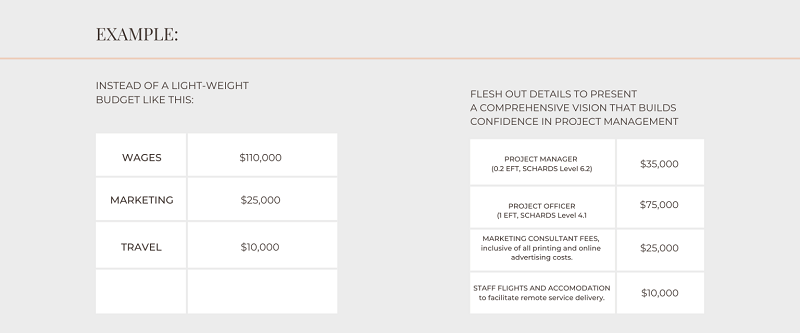How To Write Budgets To Win Over Assessors
Budgeting is everyone’s favourite topic….amirighht??
Ok I know it’s an awful task for most people, and one that you might try to just skim over / hope for the best / hand over to someone else (anyone else!) to do for you. To combat this common reluctance, I want to share some really practical tips that can dramatically boost your budget presentation within grant applications.
Applying these tips will help you:
a. Avoid some really common mistakes that can cost you dearly in the assessment process, and
b. Feel more confident with this part of grant writing, perhaps even changing your approach to tackling budgets first instead of leaving it to the dreaded end of your current grant writing process.
Let’s go!
The purpose of a thorough project budget in any grant application is to demonstrate value for money, and to win over assessors with your planning and presentation skills. To do this you need to:
1. Write detailed descriptions of your expenses
This is an opportunity to demonstrate how well you know your project, your organisation, your sector and your work processes. You should give budget line item descriptions that are as detailed as possible, and that give assessors confidence that you know what you’re doing. For example, salary costs should include the position title, SCHADS or other award (if relevant), and the EFT and duration of the role.
A nicely fleshed out budget is easier to demonstrate than discuss....

The revamped version gives a very different vibe, doesn’t it? I know that almost any assessment panel will rank this second budget higher than the first, even though it essentially presents the same thing.
2. Consider your total number of line items
I have seen draft budgets for $1 million+ funding requests that have just three line items, each of them greater than $300k. Even if it’s true that you can spend $1 million on three things only, it’s just not going to cut through or translate well to assessors.
So, what does ‘sufficiently detailed according to your funding request’ really mean? Here are some rough, ball-park figures.
If you are applying for $20,000, I’d expect to see a minimum of 5 line items (your choice of staff wages, project management, project materials, marketing, travel, monitoring & evaluation, and admin/IT/overheads).
At the other end of the scale, if you are applying for $1 million, then 50 – 100 line items would be more appropriate.
As an example – live music & event industry businesses have really interesting budgets, with huge equipment & construction costs that need to be spelled out for assessors who may not be familiar with the sector. So instead of a single ‘construction’ or ‘equipment’ line item – scaffolding, stage construction, lighting, AV, fencing, earthworks, and signage all need to be spelled out separately. If it’s not made clear, then you give space for unfavourable assumptions that you are not offering a value for money proposition.
3. Fully Value In-Kind & Cash Contributions
Appropriately valuing all in-kind & cash contributions can help boost the ‘value for money’ argument offered by your project. You want to try to increase the ratio of ‘grant funds: total project budget’.
So – make sure you include any volunteer hours (valued at $25 p/hr minimum), as well as other in-kind contributions such as IT equipment, office space, venue/event space, HR, Accounting or other project management support. All these things should be valued for your own organisation as well as any other project contributors. A number of cash contributions from your own organisation can easily be overlooked – try to fully value the management time and overheads that will be absorbed by your proposed project.
4. If you’ve got an OTT budget – attach it as supporting documentation
If you have a really detailed budget on hand, then you should include this. Some projects or events have multi-page budgets with hundreds of line items, detailed assumptions, cash flow forecasts, and various scenarios modelled out. While you won’t be assessed on these attachments, it’s really beneficial to include these to demonstrate how well organised and well planned your organisation’s finances are.
While these will absolutely boost the assessor’s perception of you – please remember they are still supplementary and won’t actually form part of your assessment. So even if they are 5-star documents, you can’t rely on them and you must still put effort into presenting a strong and sufficiently detailed budget in the template the funding administrators provide you.
In conclusion – it’s pretty easy to see through a slap-dash budget for what it is. Applying these practical tips and guidance will help you present to a much higher standard, and boost your potential for a winning grant assessment.
About The Author

Leslie Annear is an independent grant writer. Through her business Clarity Content Leslie has secured in excess of $15 million in grant funding for clients over the past 2 years.
Share this
You May Also Like
These Related Stories

When less is more: getting your first few grant wins over the line

Why goal-setting is important even in a pandemic
.jpg)
.png?width=992&height=232&name=Logo%20(1).png)